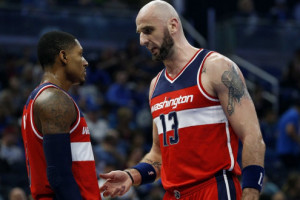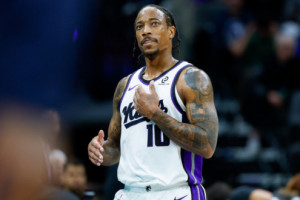Daily Fantasy NBA Tournament Strategy
If you haven’t yet, I would encourage you to read my NBA cash game strategy article. Many of the most important aspects of daily fantasy NBA are covered there.
In GPPs, many of the same elements need to be considered, but we can expound upon them in such a way that allows us to take some chances, rostering players that are a risk, but that also carry high upside and low ownership. In this article, I will cover the same points that I did in my cash game article, but apply them to GPPs.
Minutes

In cash games, we want guaranteed, or mostly guaranteed minutes. Rostering players who could easily see a reduced role due to the matchup, another player playing well, or other factors is something we want to avoid whenever possible. In GPPs, it can be quite advantageous to try to predict if a player is going to see a few extra minutes, and hence would become a great per-dollar play that very few others will have in their lineups.
An example that comes to mind is Marcin Gortat. If you ignore the stretch of the season where he was putting up big numbers on an almost nightly basis and everyone was rostering him, he was usually a low-owned center due to the presence of more attractive options at the position combined with the fact that he didn’t play heavy minutes. However, when the Wizards matched up with teams with bigger frontcourts, specifically the Bulls, Gortat would play heavy minutes because Washington needed his size on the court. Knowing that this is a likely scenario, you can roster a player like Gortat at low ownership and get nearly 40 minutes of production from a center that’s priced as if he plays around 30.
You shouldn’t attempt to predict what coaches are going to do and how certain factors will affect the playing time of certain players, but it’s a risk worth taking in GPPs.
Role
Often times, a player’s role on their team will change. This usually occurs when another player is unable to play due to an injury. We can take advantage of these types of situations before everyone else has had a game or two to look back and see what happened. An example of this is last season when Jrue Holiday was hurt. Clearly, there was going to be a scoring void that needed to be filled, but what often flies under the radar is another role Holiday has when he’s on the court – ball-handling. Not only did Norris Cole see extra ball-handling responsibilities, but Eric Gordon, the starting shooting guard, did as well. Having access to a shooting guard, which can be a difficult position to fill, who was going to not only score, but also dish out a handful of assists was extremely valuable. The key is getting in front of these shifts in roles before they happen, and before other plays are aware of them.
Injuries and Replacement Starters
There aren’t going to be any sneaky plays that pop up as a result of injuries. Everyone knows who the fill-in is going to be, and most people are going to be starting them. What I’m going to focus more on is when it is appropriate to fade players that, while they may see an increase in minutes, are unlikely to be worth using even at a reduced price tag.
I used the example of Ramon Sessions in my cash game article. That same example is relevant here. Knowing that Sessions would be high owned getting a spot start for Darren Collison in Sacramento, but also knowing that the real end result of Collison being out would simply be more work for Rudy Gay and DeMarcus Cousins, one could easily fade Sessions in some GPP lineups. Not only does that avoid a potentially high owned dud, but it allows for a variation in roster construction. Lineups tend to build themselves in NBA when there are cheap, “must have” players. Fading those players forces you to build a lineup that’s going to vary from the herd, which can be extremely profitable in GPPs.
Another example from last season is Anthony Tolliver. Tolliver saw some big minutes when Greg Monroe was forced to miss a handful of games for Detroit. Many players simply plugged Tolliver in as he was cheap and would likely see upwards of 30 minutes. This was true, but the idea that he would be anywhere near as productive as Greg Monroe was ill-founded. As a stretch four, Tolliver hung out around the perimeter on offense, content to watch Reggie Jackson shoulder much of the offensive load to make up for Monroe’s absence. He had almost no chance at a high ceiling, and even if he “reached value”, the likely result of rostering him was overpaying for a player that didn’t reach their value threshold. That’s not a recipe for success in GPPs.
Coaches

Dwane Casey was, without a doubt, one of the most infuriating coaches last season. With Gregg Popovich, you know exactly what to expect. Casey, however, was a total wild card. Some players, like Jonas Valanciunas, would start and play 20 minutes. Others, like Lou Williams, could see 30 or more off the bench. There was no predictable rhyme or reason to what he did, and he made using any of his players not named Kyle Lowry and DeMar DeRozan completely unusable in cash games.
However, these players made for great GPP targets. Valanciunas did have some big games, and he was almost always very low owned when these happened. Players didn’t want to play guessing games with the Raptors, and were likely tired of getting burned by them, so the easiest choice was to avoid the situation altogether. You can capitalize on that sentiment and take some chances, understanding that it may not work out, but when it does, you stand to profit.
Value
I touched on this briefly when I discussed Anthony Tolliver replacing Greg Monroe in the starting lineup. Value can be a misplaced idea, especially when building GPP lineups. The spot starters are always going to be high owned, even in GPPs. While they are unlikely to sink your cash game lineups, they can certainly hurt you in GPPs. Any player that is high owned is unlikely to make a difference in a GPP, but if that high owned player underperforms, your lineup likely has no chance for a big payday.
We’re trying to maximize the number of fantasy points our lineups can potentially earn, and by rostering a cheap player that’s going to see an uptick in minutes, but is unable to achieve a high ceiling, we’re limiting ourselves. It’s nice to be able to fit LeBron James, Kevin Durant, and Anthony Davis in our lineups, but the reality is that these players often don’t have big enough games to justify their inflated salaries. In GPPs, it’s advantageous to find two lower owned, middle tier players that are both capable of big games, rather than take a stars and scrubs approach.